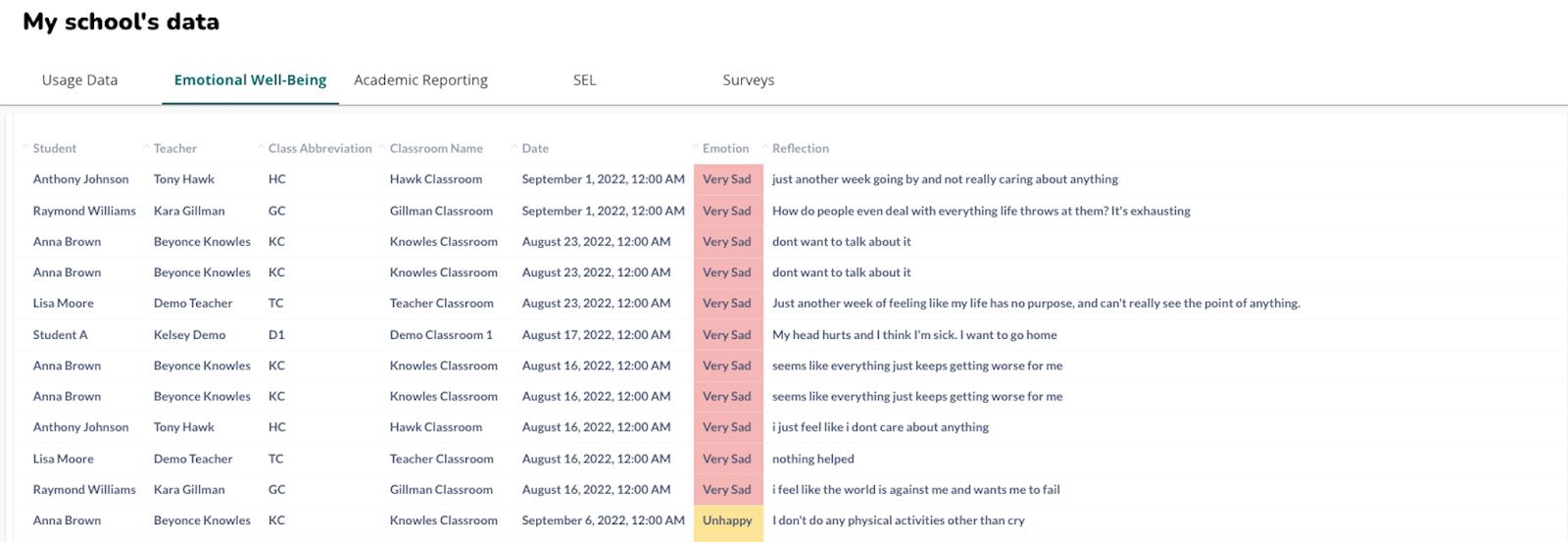Increasing Educator Capacity to Act on Learner Well-Being Data for Improved Academic Outcomes
Key Points
-
Our nation’s education system has traditionally taken a reactive approach to challenges.
-
This means that too often, the interventions come too late.
-
Sown To Grow facilitates proactive weekly pulse checks of student well-being, while not putting the sole burden on classroom teachers.

Much has been written about the social and emotional toll that the COVID-19 pandemic has taken on our young people, and for the first time, there is now national student well-being data to support our observations. Most people, including educators and families, understand that we should care not only about academic performance but also the overall social-emotional well-being of our school-aged learners. We know that educator burnout and staffing shortages have significantly worsened over the course of the pandemic. Yet, it is critical for teachers to understand the social-emotional well-being of all the individuals in their classrooms.
Our nation’s education system has traditionally taken a reactive approach to challenges, such as taking action only when there is negative behavior expressed in the classroom. The issue with responding and intervening only when the problem is noticeable means that too often, the interventions come too late. There are also many learners flying under the radar without obvious external challenges but who are still struggling. Every young person deserves the opportunity to thrive and learn at their best.
In the Social-Emotional Learning (SEL) space, there are two categories of tools: 1) curriculum (e.g. Second Step), and 2) assessment (e.g. Panorama). In the past, SEL assessments tended to be one-time or infrequent for an aggregate pulse of a school’s climate. In recent years, there has been a shift toward more frequent check-ins and personalized feedback, for the purpose of timely, actionable improvement for individual learners.
With thoughtfully-designed technology, educator capacity can be increased to pay closer attention to something so fundamentally valuable like learner well-being, which in turn impacts one’s ability to learn and perform at their best.
Jean Liu
One tool offering both SEL curriculum and more frequent assessments is Sown To Grow, supported by organizations such as Digital Promise and aligned with CASEL. Sown To Grow facilitates proactive weekly pulse checks of student well-being, while not putting the sole burden on classroom teachers to notice and request interventions for those in need.
According to learning science research, “people learn best when they are in constructive emotional states versus ones of excessive stress or anxiety.” SEL has been proven to improve academic achievement by an average of 11 percentile points. Acknowledging the direct link between a learner’s emotions and motivation to learn is the foundation of Sown To Grow. CEO and Founder, Rupa Gupta, describes SEL as how we support learners so that they can feel seen, supported, and learning at their best. It must be comprised of both:
- empowering students to build their skills and
- providing supports to help students with challenges outside their control.
Learners
At its most basic level of usage, Sown To Grow provides an opportunity for learners to provide weekly check-ins by selecting the emoji that most reflects their mood and a space to type in a short reflection. They can also see a graph of how their mood has shifted over time and their past reflections.
Building a small habit of weekly reflection enables a more positive and proactive approach to student well-being. Students learn to not only recognize when they are having a tough time, but also to notice when things are going well. They can build more resilience and are empowered to take action to overcome their challenges to get back to a more positive place.
Sown To Grow has observed that digital natives are more inclined to share openly in a digital format over talking to an adult. One learner commented: “Even if I have a great relationship with my teacher, for me as a 16-year-old to walk up to an adult and tell them I’m having a tough time, that’s hard. But in an online interface, even though I know that the teacher is reading it, there’s this safety of dropping things in there.”
Teachers
For teachers, they are able to see a dashboard of how the individuals in their classroom are feeling to determine who might need additional support. There are also suggested responses that teachers can use to streamline their feedback process, or they can personalize their response.

Administrators
At the administrative level, Sown To Grow produces a school-wide summary report that flags any learners that may have multiple weeks of negative feeling emojis, as well as alerts to identify individuals who may have a concerning emotional state in need of a more urgent intervention. Counselors and school leaders can see if a teacher has already connected with a particular individual or if they are the first ones to reach out. This allows the burden of noticing students in need to be shared by the primary classroom teachers, counselors, and school leaders, so that there are more opportunities for adults at school to connect and provide support.

While adding “one more thing” to teachers’ growing set of responsibilities is always top of mind and a very valid concern, Sown To Grow is heavily focused on making the tool very easy to use for teachers as well as sharing the responsibility more broadly. After all, at the heart, every teacher cares about each of their learners’ well-being, and so this tool enables them to more proactively and efficiently check in and act as needed.
Another essential component to student well-being and academic health is encouraging an open line of communication between learners and their parents/caregivers. Sown To Grow is committed to protecting student privacy and invites young people to use their voice to talk about any challenges they may be facing, such as using student-led conferences as a space to share their social-emotional data with their parents/caregivers.
For those schools and districts who wish to go beyond the weekly emoji check-ins and reflections, Sown To Grow also offers more advanced capabilities including academic check-ins, academic goal-setting, deeper reflections centered around SEL competencies, and embedded SEL curriculum.
It can be challenging to systematically measure social-emotional well-being of an entire classroom on a frequent basis. With thoughtfully-designed technology, educator capacity can be increased to pay closer attention to something so fundamentally valuable like learner well-being, which in turn impacts one’s ability to learn and perform at their best. As Gupta captures it, “If we can deliver on the three goals of ensuring students are seen, supported, and learning at their best, we’re changing the game for access to rigorous education, well-being, helping students thrive and reach their dreams, even knowing the scope of their dreams.”








0 Comments
Leave a Comment
Your email address will not be published. All fields are required.